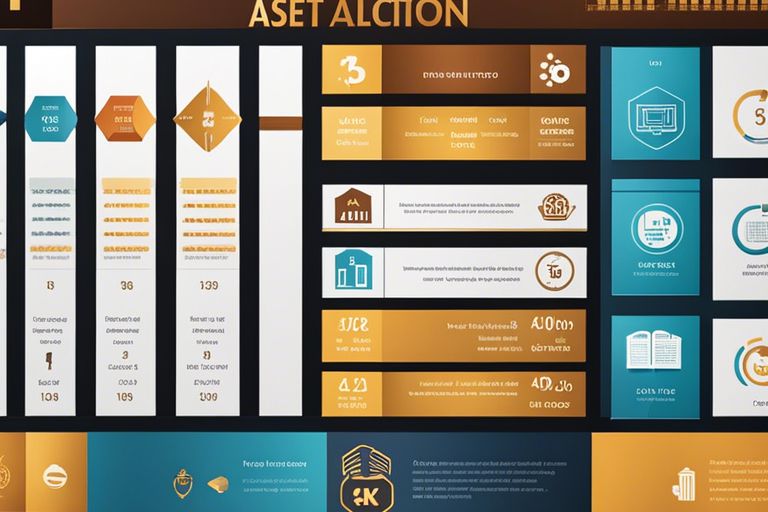Strategy is key when it comes to investing for your future, and one of the most critical factors to consider is determining the right asset allocation to achieve your investment goals. Your asset allocation strategy will have a significant impact on the overall performance and risk level of your investment portfolio. By understanding the different asset classes, your risk tolerance, and investment timeline, you can determine the optimal mix of investments that align with your financial objectives. In this comprehensive guide, we will investigate into the various aspects of asset allocation and provide you with the necessary tools to make informed decisions for a successful investment journey.
Key Takeaways:
- Understand your investment goals: Before determining the right asset allocation strategy, it’s crucial to have a clear understanding of your investment goals, risk tolerance, and time horizon.
- Diversification is key: Diversifying your portfolio across different asset classes can help mitigate risks and maximize returns over the long term. Allocate your assets based on your risk tolerance and investment objectives.
- Regularly review and rebalance your portfolio: Market conditions and your financial situation can change over time. It’s important to periodically review your portfolio and rebalance it to maintain your desired asset allocation and ensure it aligns with your investment goals.
Understanding Asset Allocation
Before entering into the specifics of determining the right asset allocation strategy for your investment goals, it is important to understand the concept of asset allocation and its significance in achieving financial success.
Definition of Asset Allocation
To put it simply, asset allocation refers to the distribution of your investment portfolio across various asset classes such as stocks, bonds, real estate, and cash equivalents. The goal of asset allocation is to create a diversified portfolio that can help you achieve your financial objectives while managing risk.
Importance of Asset Allocation in Investment Goals
Goals In terms of investing, asset allocation plays a crucial role in determining the overall performance of your portfolio. The right mix of assets can help you achieve a balance between risk and return, ultimately leading to long-term success. Ignoring asset allocation or having an imbalanced portfolio can expose you to unnecessary risks and may result in suboptimal returns.

How-to Guide: Developing Your Asset Allocation Strategy
Some of the most important decisions you will make when it comes to investing are related to your asset allocation strategy. This strategy will determine how you divide your investment portfolio among different asset classes to achieve your financial goals.
Tips for Assessing Risk Tolerance
- Understand your financial goals: Before determining your risk tolerance, you must have a clear understanding of your investment objectives.
- Assess your time horizon: The length of time you have to invest can greatly impact your risk tolerance.
- Consider your emotional comfort with risk: Some investors are more comfortable with market fluctuations than others.
- Consult a financial advisor: A professional can help you assess your risk tolerance and develop an appropriate asset allocation strategy.
This comprehensive assessment will help you determine the level of risk you can handle in your investment portfolio. It’s important to remember that risk tolerance can change over time, so it’s wise to revisit this evaluation periodically.
Factors That Influence Asset Allocation
- Investment goals: Your short-term and long-term financial objectives will play a significant role in determining your asset allocation.
- Time horizon: The length of time you have to invest can impact the level of risk you can take on.
- Risk tolerance: Your comfort level with risk will influence how aggressively you allocate your assets.
Asset allocation is influenced by a variety of factors that can vary from one investor to another. These factors include your investment goals, time horizon, risk tolerance, and market conditions. By considering these factors carefully, you can develop a well-rounded asset allocation strategy that aligns with your unique financial situation.
Implementing Your Asset Allocation Plan
Once again, to effectively implement your asset allocation plan, you can refer to resources such as How to Achieve Optimal Asset Allocation. This will guide you on the best practices and strategies to put your plan into action.
How-to Choose the Right Assets
If you are unsure about which assets to include in your portfolio, consider factors such as risk tolerance, time horizon, and investment goals. Diversifying across various asset classes like stocks, bonds, real estate, and commodities can help spread risk and optimize returns.
Diversification Tips for a Balanced Portfolio
- Allocate assets based on your investment horizon and risk tolerance.
- Consider including a mix of equities, bonds, and alternative investments to reduce volatility.
- Regularly rebalance your portfolio to maintain desired asset allocation.
Right diversification is key to managing risk and maximizing returns in your investment portfolio. By spreading your investments across various asset classes, you can achieve a more stable and potentially profitable portfolio while safeguarding against market fluctuations.
Plus
Recognizing the importance of diversification can help you avoid concentration risk and protect your investments from adverse market conditions. By diversifying your portfolio effectively, you can minimize potential losses and enhance long-term growth opportunities.
Monitoring and Adjusting Your Asset Allocation
How-to Review and Rebalance Your Portfolio
The key to successful investing is not just about setting your asset allocation strategy but also about regularly monitoring and adjusting it to ensure it aligns with your investment goals. The fluctuations in the market can impact your portfolio’s mix of assets, leading to a drift from your target allocation. Therefore, it is vital to review your portfolio periodically and rebalance it to bring it back to the desired mix.
Indicators That Your Asset Allocation Needs Adjustment
AllocationReviewing your asset allocation on a regular basis is crucial to ensure it remains in line with your financial objectives and risk tolerance. Signs that your asset allocation needs adjustment include significant market changes, shifts in economic conditions, changes in your financial goals, or a shift in your risk tolerance. Being proactive in identifying these indicators can help you make timely adjustments to your asset allocation to stay on track with your investment objectives.
Summing up
Drawing together all considerations discussed here, it is vital to carefully determine the right asset allocation strategy for your investment goals. By understanding your risk tolerance, time horizon, and financial objectives, you can create a diversified portfolio that aligns with your needs. Remember to periodically review and adjust your asset allocation to stay on track with your goals and adapt to changing market conditions. By following these principles, you can increase the chances of achieving financial success and growing your wealth over the long term.
FAQ
Q: What is asset allocation?
A: Asset allocation is the strategy of dividing your investment portfolio among different asset classes such as stocks, bonds, and cash equivalents. It is a crucial decision that can have a significant impact on the performance and risk of your investments.
Q: How do I determine the right asset allocation for my investment goals?
A: To determine the right asset allocation for your investment goals, you should consider factors such as your risk tolerance, time horizon, financial goals, and investment knowledge. It is important to create a diversified portfolio that aligns with your objectives and helps you achieve a balance between risk and return.
Q: What are the common asset allocation strategies I can consider?
A: Some common asset allocation strategies include aggressive, moderate, and conservative approaches. Aggressive strategies involve a higher allocation to stocks, which carry more risk but also offer higher potential returns. Moderate strategies typically combine stocks and bonds to achieve a balance between risk and return. Conservative strategies focus more on preserving capital and often allocate a higher percentage to low-risk investments such as bonds and cash equivalents.




